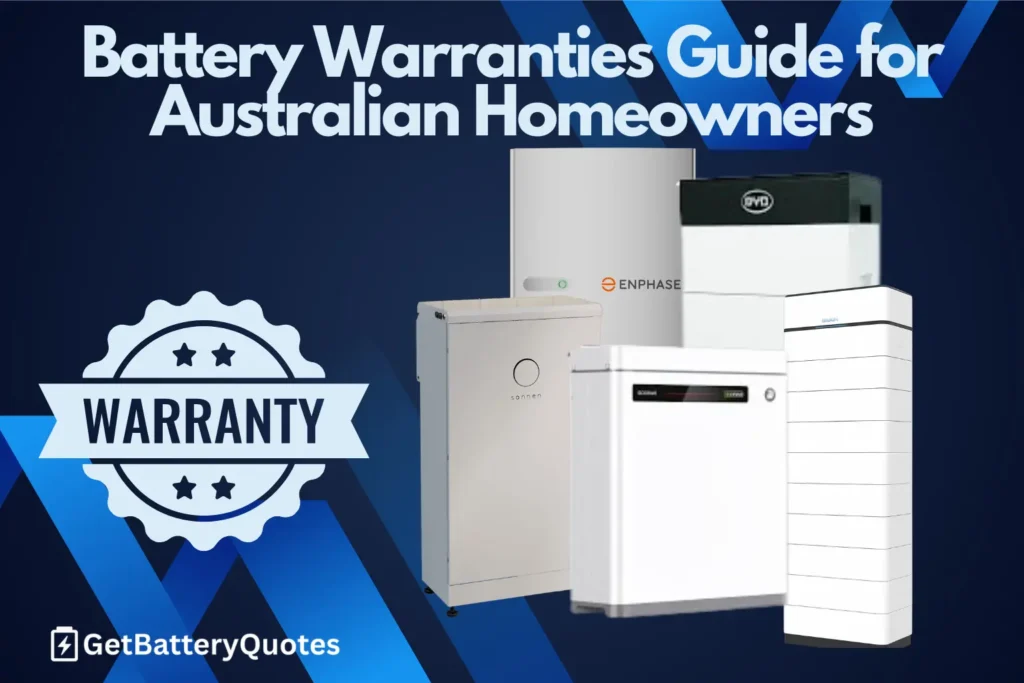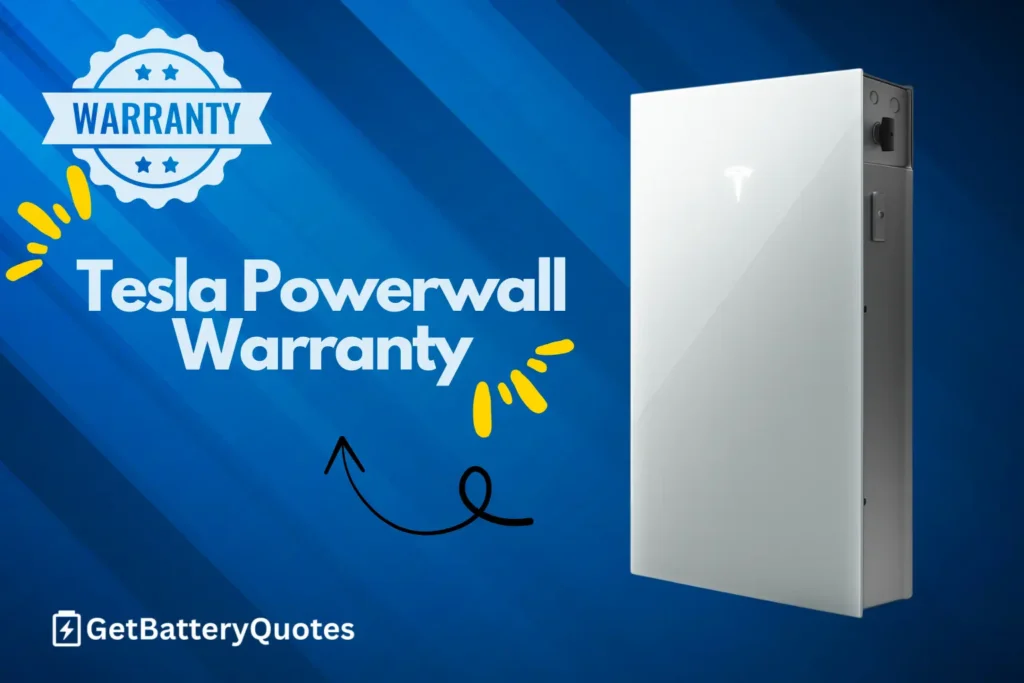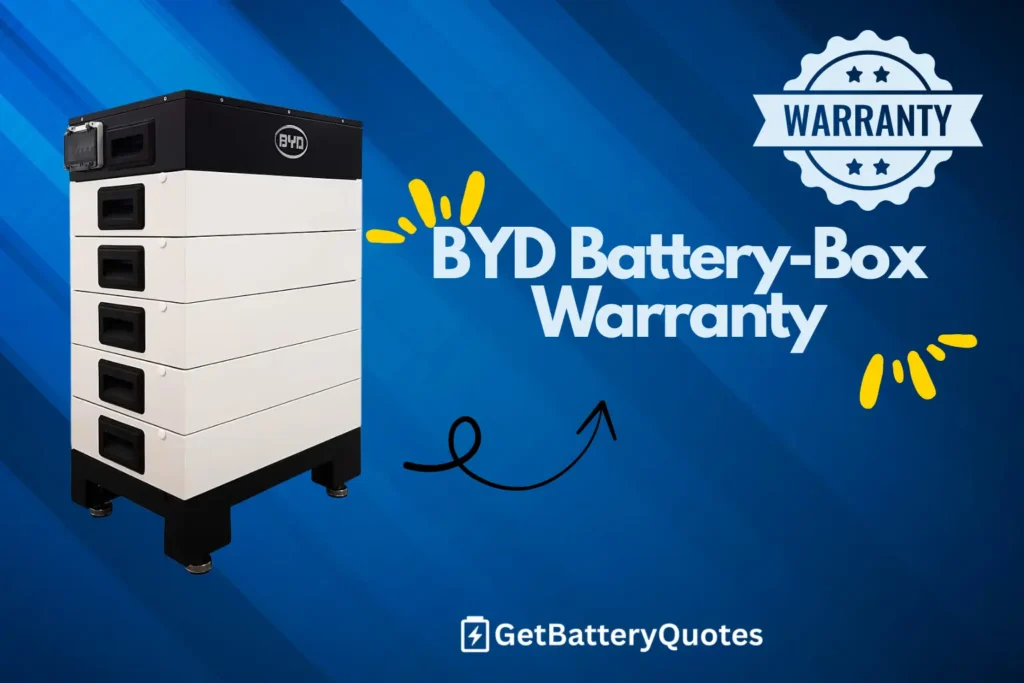Battery Warranties Guide for
Australian Homeowners
Table of Contents
- 1. Understand What You’re Really Getting With That 10-Year Warranty
- 2. Types of Battery Warranties:Product vs. Performance
- 3. Key Warranty Terms Explained
- 4. How to Read a Battery Warranty Document
- 5. Real-World Example: Tesla Powerwall Warranty
- 6. Real-World Example: BYD Battery-Box
- 7. Pro-Rata vs Full Replacement: What’s the Difference?
- 8. Warranty Claims: What’s Typically Covered?
- 9. Warranty Fine Print: Traps and Limitations to Watch For
- 10. Brand Warranty Comparison Table
- 11. Battery Warranty Myths vs. Reality
- 12. Final Verdict: How to Choose a Battery with a Good Warranty
Understand What You’re Really Getting With That 10-Year Warranty
If you’re considering a solar battery for your home, the warranty is just as important as the brand, size, or price. A good solar battery warranty can protect you from costly replacements, give you confidence in product quality, and help you compare models on more than just specs.
But here’s the truth: not all 10-year warranties are equal. Some are based on usage limits, some include exclusions you won’t find until you read the fine print, and others only cover part of the replacement cost after a few years.
In this guide, we’ll break down how solar battery warranties work in Australia including the difference between product and performance warranties, how throughput and cycles work, and how top brands like Tesla, BYD, and Sungrow compare.

Key Warranty Terms Explained
Years vs. Cycles
- Years: Most warranties last 10 years from installation.
- Cycles: One full cycle = charge to 100% and discharge to 0%.
- Batteries used daily could hit 3,000+ cycles in 10 years.
- Warranties often end whichever comes first years or cycle count.
Throughput (kWh or MWh)
“The warranty lasts 10 years or 29.2 MWh throughput whichever occurs first.”
Usable vs. Nominal Capacity
- Nominal is the total rated size (e.g. 10 kWh).
- Usable is what you can actually access (e.g. 9.6 kWh after accounting for battery management settings).
- Most warranties refer to usable capacity but some don’t. Be sure.
End-of-Warranty Capacity (State of Health, or SoH)
Most performance warranties guarantee the battery will retain a certain SoH at the end of the term often:
- 60–80% of original usable capacity
- Varies by brand: e.g. Tesla = 70%, BYD = 60%, Sonnen = 80%
This is crucial. A battery that loses 40% of its capacity over time may still technically be “under warranty” even if it no longer meets your needs.
How to Read a Battery Warranty Document
Start with These Sections
1. Warranty Period
Check how long the product and performance warranties last. Are they both 10 years? Are there any conditions that shorten this?
2. Capacity Guarantee
Look for phrases like “End of Warranty Capacity” or “Guaranteed State of Health.” This tells you how much usable capacity the battery must retain by the end of the warranty.
3. Usage Limits
- Total energy throughput (e.g. 30 MWh over 10 years)
- Maximum daily cycles (e.g. 1 cycle per day)
- Calendar vs operational year limits
4. Exclusions
- Damage from improper installation or inverter pairing
- Use outside the specified temperature range
- Failing to update firmware or use the manufacturer’s app
- Outdoor installation (if not explicitly allowed)
Real-World Example: Tesla Powerwall Warranty
- Product warranty: 10 years
- Performance warranty: 70% usable capacity after 10 years
- Throughput: 37.8 MWh for general use
- Must be connected to Tesla app and meet installation criteria


Real-World Example: BYD Battery-Box
- 10-year performance warranty
- Capacity retention: 60%
- Throughput varies by model
- Must be paired with compatible inverters and installed per BYD guidelines
Tips for Homeowners
- Always download the warranty document before purchase
- Ask your installer to explain any unclear terms
- Keep records of your battery’s usage, inverter settings, and maintenance
- If in doubt, choose a battery from a brand with local support and a clear claims process
Pro-Rata vs Full Replacement: What’s the Difference?
What’s Usually Covered
- Manufacturing defects
- Early capacity loss
If your battery drops below the guaranteed usable capacity before the warranty period ends and you haven’t exceeded usage limits.
- Component faults
Some warranties extend to included components such as a battery management unit or internal inverter (if it’s a hybrid system).
What’s Usually Not Covered
- Installer error
- Unsupported inverter pairing
- Overuse or misuse
- Environmental damage
- Unmonitored systems
Installer vs. Manufacturer: Who’s Responsible?
- Manufacturer: Responsible for defects, faulty hardware, or early capacity loss under warranty.
- Installer: Responsible for design, installation, and system setup.
- If your battery fails due to incorrect wiring or settings, the manufacturer may decline the claim.
That’s why it’s essential to choose both a trusted battery brand and a Solar Accreditation Australia (SAA) accredited installer.
Warranty Claims: What’s
Typically Covered?
Full Replacement Warranty
- Replace or repair the battery at no cost
- Cover 100% of the cost during the warranty period
- Often applies for manufacturing faults or performance loss within the specified limits
Pro-Rata Warranty
- The longer you’ve owned the battery, the less value the manufacturer will cover
- You may be offered a partial refund, a discounted replacement, or asked to pay the difference
Why It Matters
- A 10-year warranty with pro-rata terms might sound good but offer limited value after year 5.
- A 7-year full replacement warranty could actually be better in real-world use.
Always check how the warranty is structured not just the headline number of years.
Warranty Fine Print: Traps and Limitations to Watch For
Outdoor Installation Requirements
- Some batteries are only covered under warranty if installed indoors or under shelter
- Outdoor-rated models must often be installed off the ground and away from direct sunlight or water ingress
- Breaching these terms can void the warranty even if the battery is technically outdoor-rated
Inverter Compatibility
- Many brands only warrant their battery if paired with an approved inverter
- Pairing with unsupported brands can trigger auto-rejection of warranty claims
Internet and App Connectivity
- Brands like Tesla, Enphase, and Sonnen require the battery to be connected to their cloud platform
- If you disable the internet or remove the app, the warranty may be void or you may be unable to make a claim
Maintenance and Data Logging
Some warranties require:
- Access to data logs
- Installer or customer app check-ins
- Firmware updates and ongoing connectivity
Environmental Conditions
Operating the battery outside of:
- Temperature range
- Humidity range
- Altitude or ventilation guidelines
…can all invalidate warranty coverage.
Transferability
- Not all warranties are transferable to new owners if you sell your home. Even when they are, you may need to register the transfer within a specific window
DIY Installation or Modifications
- Any non-CEC accredited installation work or modifying wiring/settings without approval often voids your coverage immediately
Takeaway:
Brand Warranty Comparison Table
| Brand | Warranty Length | Cycles / Throughput | End-of-Warranty Capacity | Warranty Type |
|---|---|---|---|---|
| Tesla | 10 years | 37.8 MWh throughput (daily use) | 70% | Full replacement |
| BYD | 10 years | Varies by model (e.g. 29–38 MWh) | 60% | Full replacement |
| Sungrow | 10 years | 6,000 cycles | 70% | Full replacement |
| AlphaESS | 10 years | 10,000 cycles (claimed) | 80% (model dependent) | Pro-rata on some models |
| Enphase | 15 years | Unlimited cycles (within SoC) | 70% | Full replacement |
| Sonnen | 10 years / 10,000 cycles | 10,000 cycles | 80% | Full replacement |
| GoodWe | 10 years | Varies by model | Typically 60–70% | Some pro-rata |
| iStore | 10 years | Throughput not always disclosed | 60–70% (model dependent) | Conditions vary |
Note: Data sourced from publicly available warranty documents as of 2025
Key Takeaways
- Tesla and Enphase offer some of the strongest coverage, with generous throughput or unlimited cycles and clear documentation.
- Sonnen and AlphaESS provide high cycle allowances, but claims must be validated against usage data.
- BYD, GoodWe, and iStore have solid terms, but warranties may vary by model always check the specific datasheet.
Battery Warranty Myths vs. Reality
There’s a lot of confusion around solar battery warranties and it’s easy to be misled by marketing, assumptions, or outdated advice. Here are the most common myths we hear from Australian homeowners, and the reality behind them.
All 10-year warranties are the same
If my battery fails, the manufacturer will just swap it.
Once it’s installed, I don’t need to worry about it.
A higher number of cycles means a better battery.
The warranty starts when I buy the battery.
A warranty claim will be handled by the installer.
If my battery’s dead, it’s always covered.
Warranties on car batteries and solar batteries work the same.
Final Verdict: How to Choose a Battery with a Good Warranty
What to Prioritize
- Compare more than just years look at cycles, throughput, and end-of-warranty capacity
- Check for full replacement terms not all warranties cover 100% of the cost in later years
- Stick with proven brands Tesla, BYD, Enphase, Sonnen and others offer strong protection
- Use a SAA accredited installer this is currently required by many manufacturers to validate a claim
- Read the warranty, or work with someone who has don’t assume it’s “standard”
What It Means for You
Whether you’re adding a battery to an existing solar system or starting fresh, a good warranty is your safety net. It can protect your investment, reduce risk, and give you peace of mind that you’re buying quality not just capacity.


